-
Posts
1,751 -
Joined
-
Last visited
-
Days Won
3
Content Type
Profiles
Forums
Blogs
Gallery
Events
Store
Posts posted by Dieter3
-
-
Yes! For those that participated in (I'd imagine in a significant way) the rebuilding of Tokyo after the 1923 quake. They are really nice medals!
0 -
I guess I'm surprised at the somewhat low numbers on those documents, given the late years! Am I reading that wrong?? Very neat!!
0 -
Here's what I believe - the lack of screws I believe is a very late war feature, but also carried into later production when it was resumed. The only reason I say this is because of a few specimens I have observed at auction in Japan that included documents, dated Showa 19 (1944). My theory is that when production was resumed this construction was still used for a little while and then the screws were adopted soon thereafter. Later specimens that included documents at auction show these screws not to mention - current Sacred Treasure uses these screws in construction, so I don't think it could be recent unless they flip-flopped on construction techniques, which doesn't make sense.
I believe it went: Rivets -> Plain -> Screws
No??
0 -
Hello! I'll have to look more closely - but it appears the case is all one blend of Bakelite, I'll check it again though! It's pretty good if it was home-made! Why do you hypothesize that that it is self-made?
0 -
-
-
-
Thought this was an interesting find. Yuukoushou with some different characteristics - it has some of the simplified features like a plain pin attachment for both the medal and the rosette. The case seems to be made of Bakelite like those postwar Rising Suns and Sacred Treasure cases, but with a lot more heft. The hinge is a pin running through the back of the case, not like the lacquered cases. I believe it is of aluminum. Different style hasp, that was used on some later awards (post-1956) - I'm only guessing, but this might be an actual war-era award, but must be pre-1956 before the Red Cross adopted separate silver and gold awards around that time. The medal itself seems to be of high quality, but the other features seem to hint at a lack of resources during or right after the war. That, or I have no idea what this is. Anybody have any ideas?
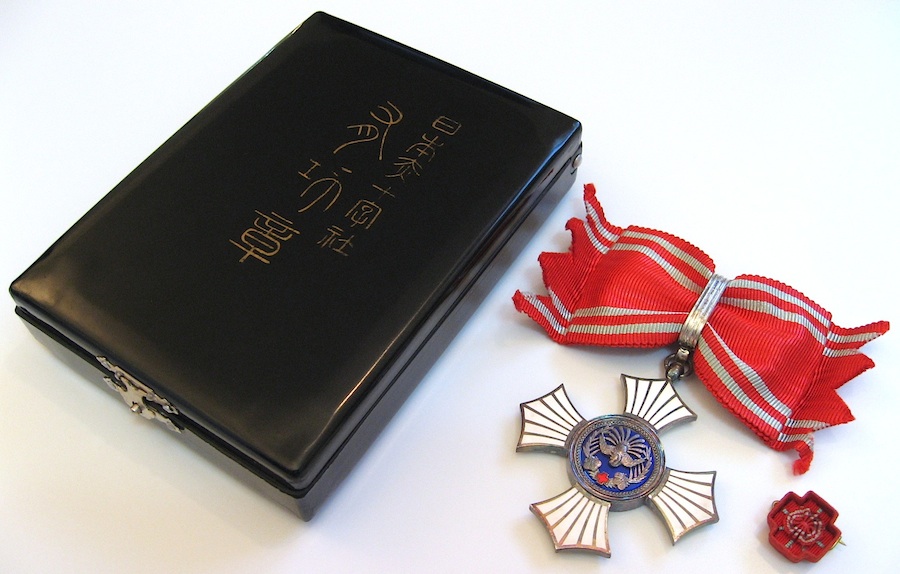 0
0 -
Here's another one, the wrapper with a different date than above, earlier production, Showa 5 compared to Showa 6. Anybody know the span of production for these? Rich, does any of your literature indicate? There don't appear to be any differences except for the date.
 0
0 -
So.......I know there is a "wanted" and "sale" section on the board, but would it be allowable to have these here specific to Japanese Only items? Might be somewhat redundant, but I think it would be more to the point. I think we could do without the FOR SALE part, but the WANTED, what do yo all think?
0 -
Speaking of hallmarks, and rather than starting a new thread just for this, I figured I'd post it here - check your Orders of Merit - anybody have any marks on theirs? Found this on one that just arrived, kinda neat. This is Yuukoushou in a black lacquer case. Believed to be perhaps an older styling of the word "kotobuki", but not sure.... Rich? Paul?
Of the silver and gold orders I have, I've never seen a hallmark except on the button rosettes occasionally, never the medals. This is the first one, but I'm wondering if this was applied by other than the maker after the fact. Any ideas?
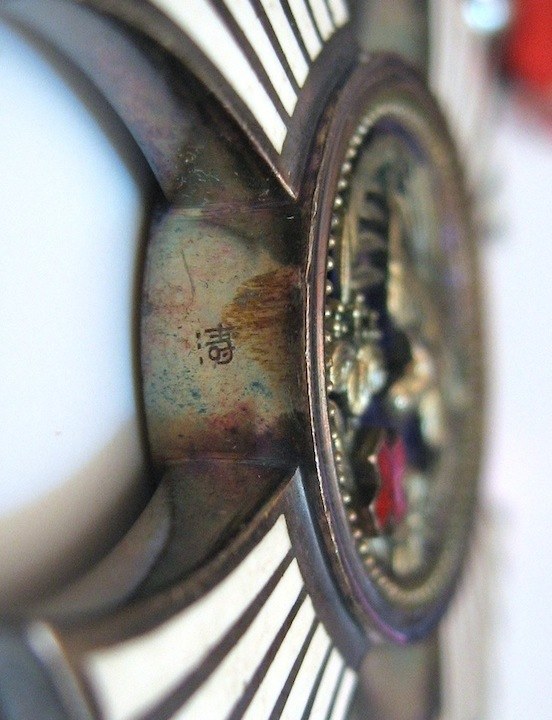 0
0 -
3rd Class, Order of the Rising Sun - Earlier style
1 -
Very cool! Thanks for posting. I'm glad they included a picture of him wearing the medal.
0 -
Interesting. So it sounds like up to 1943, the RC merit medal must have been minted by independent firms. Does it indicate if they were exclusive to the Japan Mint??
0 -
These must be among the rarest of medals!
0 -
Hmmm, you'd take the 1874 Medal, really? If I'm not mistaken, the 1887 Gold Medal of Honor is a pure gold medal!
Well.....that might change things a bit! That I did not know, not just just plated? The medals themselves then should hold up very well to time! I'd have to seriously reconsider this choice! Not that it will ever present itself to me, but......
0 -
Yep, two 1874 war medals sold last year that I saw - one for 380,000 the other for 514,000 - again, missing the hook and catch. Both had cases, don't know if they were original though.
Your logic is certainly the same as mine - the more rare you get, the higher the price. Makes sense to me! But you earlier comment on context DOES apparently win the day! War medals must hold more appeal in general, and I must admit if I had 500,000 yen and I had a choice between the gold honor medal or the 1874 war medal - even KNOWING how rare that gold one is thanks to you, I'd still probably buy the 1874 one!
0 -
Unlike my last 'discovery' of the number of 1940 2600th Natl Foundation medals minted, this new proclamation of mine is much more substantial. The number of 1887 Yellow Ribbon Medals of Honor awarded are as follows:
572 silver medals and 54 gold medals. And Peterson was right when he wrote that the last medal awarded was in 1894.
(PICTURES here on my site: http://www.imperialj...erityellow.html)
Very low numbers for both, which justify the high prices. However, when compared with prices for the 1874 War Medal (3,677 minted), the prices seem reasonable. Silver 1887 medals sell for around 120,000 yen, but the 1874 Medal sells for much more (one example sold in Japan this week for 221,000 yen--no case). I guess context is important since war medals are more highly regarded by many collectors.
Anyone have a gold 1887 medal? I've never even seen a photo of one.
The information on this medal I got in a fantastic book I found this week. It is a history of the Medals of Honor, published in 1941. Not so much as a history but a compilation of almost every recipient of the five types of medals. (Only the Dark Blue Ribbon Medal list is incomplete.) Unbelievable resource since the names & addresses of the recipients are listed as well as some descriptions of what they did to deserve the medals. As you can imagine, it is a huge book. It may weigh as much as my 6-year-old. If anyone has a named pre-war medal, I can help find a little bit about the original owner.
Cheers, Rich
Excellent topic on all counts!! I can only dream of medals like this.
Did you catch the 1874 War medal today that BIN'd for 450,000? Similiar to the other, notice they both were missing hooks and catches (re-ribboned?) though today's sale had a somewhat interesting case with a little space for the ribbon bar, also included. Kinda neat, but not original me thinks.
0 -
AH!! Yes, I didn't even think of that angle either! That certainly makes sense. Wouldn't it be nice if they could have mentioned medals made OTHER than at the Osaka mint too!?? But that'd be too easy..... ;)
0 -
The 2600th Year Anniversary medal? This is interesting, but possibly inaccurate - I have observed document# 222,258 (have it in my notes). That 1600 would make the female version downright rare if you ask me!
0 -
Yes, interesting indeed! The marks do however seem to be within a specific period of years as early pieces of silver do not appear with hallmarks but later ones do. The trick is figuring out which period! One thing though that kinda furthers that mystery though is that certain medals found in paper boxes can bear the same mark as those found in the later "pasteboard" cases. (I'm also suspicious of certain pieces being of an alloy, not aluminum or silver, that bear hallmarks as well. I don't think these pieces were limited to silver or aluminum only, but that is another topic.) It does make sense that these marks could indicate at least a series of sorts, periods make sense too.
Does the history indicate that any red cross medals were made by Osaka? I've never seen one with the characteristic "M"! Though "S" exists, I thought maybe that was the same company that made the S-marked Showa Enthronement medals.
You probably already know that weapons like guns and bayonets used katakana to indicate a series after a certain period in time, but these were strictly numerical runs, with varying series being given to different manufacturers, but these are included other marks to indicate the arsenal that made them as well in addition to the series marks and serial#s. I've tried to relate the marks on medals to the rhyme and reason of weapons manufacture, but it doesn't work!
0 -
Any updates on this??
0 -
I might recommend a wax like Renaissance wax. I use this on certain gun parts, as well as antique cartridges. It is best on smooth surfaces of course and can be hard to work with on rough surfaces and relief. Just a thought!
0 -
so they use new dies??
Not sure. I haven't compared this one directly to earlier 6th classes. I've been meaning to do so to see about similarities or differences, just haven't gotten around to it yet. Of course the one major difference is the paulownia suspension used on these that is not used on its predecessors - so there's a change at the top of the ray portion of the medal for sure. The ring of jewels might be the same as earlier pieces being attached with the screws.
0




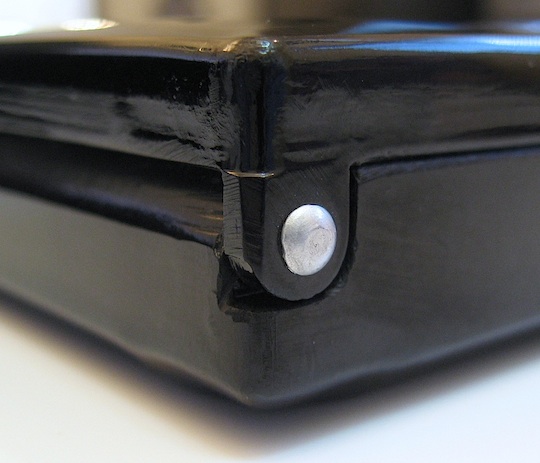
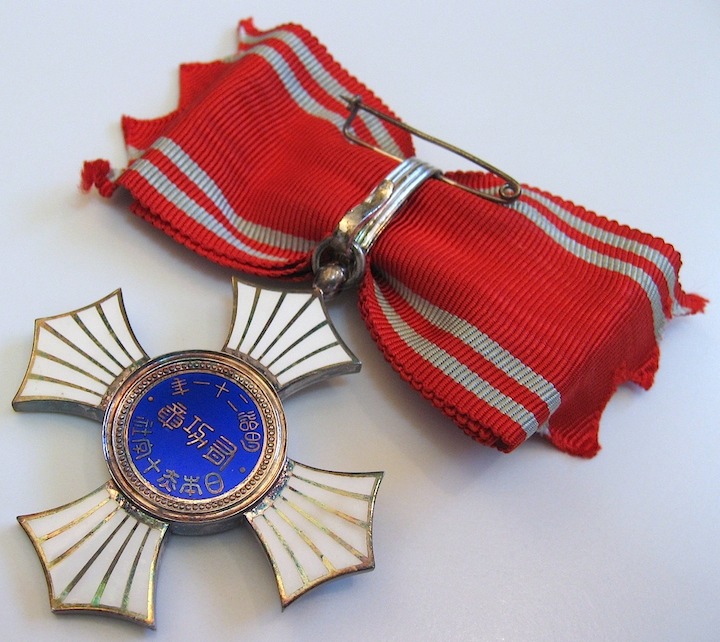
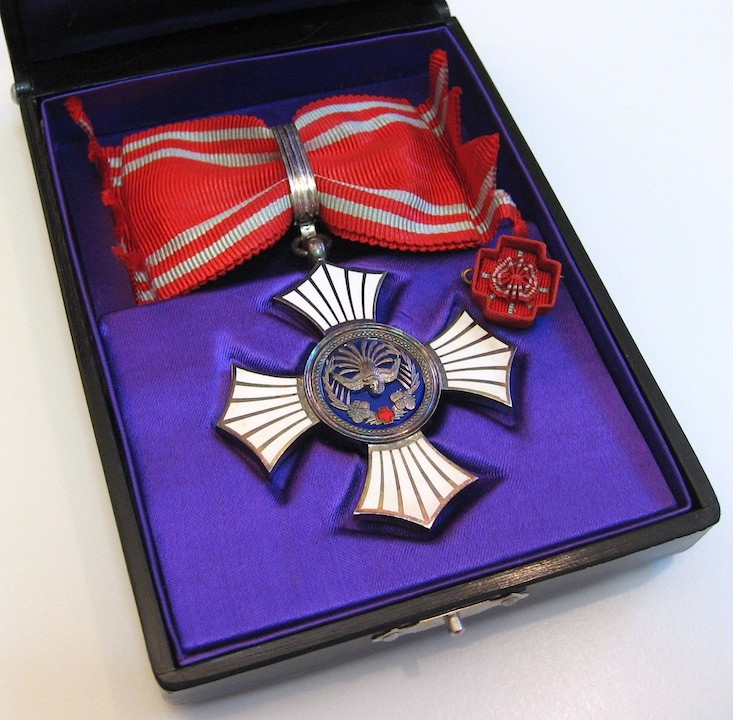
Red Cross - Lady's Order of Merit
in Japan
Posted
Thank you all for the input!!! This is exactly what I was hoping for!!
Hi Nick,
Yes, in fact a very similar type of clasp was used in both the silver and gold orders of merit on the cases that I believe were probably some of the first, post-1956 - they are the more narrow type, before the wider type was adopted. This is also a thinner clasp, not as generous in the use of metal, very plain, not like the use of brass or nickel or other more luxurious metals - though I don't know the construction of this one!
Hi Richard,
Well, it is somewhat lost on me as to what medals were available. I believe that late in the war, aluminum was less in demand as aircraft manufacturing was ramping down, no?? I know other bits of metals like steel, iron, brass, chrome, all of these were harvested in the tiniest bits that seem insignificant, but were needed to manufacture the late crude war weapons that would be necessary in an anticipated homeland defense. So aluminum seems likely - the luster, the feel - it could be a cheap alloy.
Agree! The "cheapened" features of both the case and medal make me believe this was from a period where resources were much more limited - wartime, or soon thereafter.
Indeed!! But we do know that the Yuukoushou evolved into the Silver and Gold Merit awards in 1956-ish, according to Red Cross literature - so when one sees the kanji for silver or gold, we can at least assume pretty safely I think that the award was post-1956! Same with the Special Membership medals. Other features though certainly give clues as to the time frame, but yes, slippery territory!!
Again, I defer to the lack of resources and skill associated with wartime or the period immediately following the war! The case is not of a low quality - it is very good - but it is not quite as nice as a wood-lacquer case. Functionally though, excellent. Care seems to have been put into it's construction, but Bakelite does cheapen the feel.
Not completely, but again it is not bad at all. Some other order cases are a bit tweaky, especially other Bakelites like the post-war 7th and 8th class - some of them line up nicely, some do not. I'd imagine time takes it's toll!